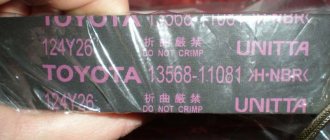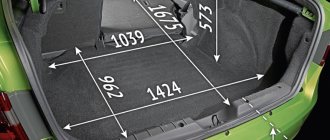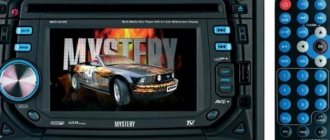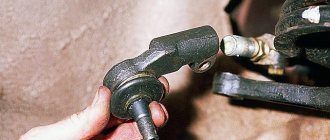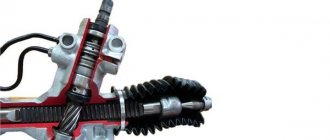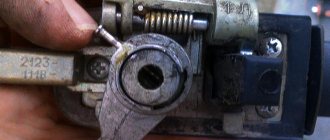Engine magazine continues to test the strength of automotive parts. This time we decided to check the steering tips for one of the most popular cars on the Russian market - Renault Logan . To do this, we purchased an original Renault and ten analogues of different price categories. Read on to find out what came of it.
So, the original Renault steering end with the original number 485202867R is used not only on the Logan and Sandero models, but also on the domestic analogue of the Romanian-French station wagon - Lada Largus. A good quality part is made in France and has a decent price: 1945 rubles.
Spare parts of the following brands were taken as analogues:
Test method
The test methodology is based on GOST R 52433-2005 “Automobile vehicles. Ball joints. Technical requirements and test methods”, which also applies to tie rods with ball joints (steering ends).
Tests related to the force of tearing and extrusion were carried out by applying a vertical load on a universal tensile-compression machine R20 in the laboratory of NPO Talis LLC; tests were also carried out there to test the anthers for frost resistance.
The minimum permissible values of the pullout force and the force of squeezing the pin out of the joint body are indicated in Appendix A to GOST, depending on the diameter of the ball pin. In this case, our steering tips have two pin sizes (22 and 25 mm), therefore, according to GOST, their minimum applied forces must differ. True, from a logical point of view, within the framework of applicability on the same car, this is not entirely true.
In the range of finger ball diameters from 21 to 24 mm, the minimum force for pulling out is 1500 kgf, for extrusion - 1900 kgf. For balls with a diameter of 24 to 27 mm - 2000 and 2500 kgf, respectively. The original ball joint did not come with a nut to attach it to the steering knuckle, so I had to use a heavy-duty Moog ball joint nut.
Having an original part in hand, we will consider its parameters as reference ones, since these are the characteristics that the manufacturer set for their car. In this case, we see that with a ball diameter of 22 mm, the pullout force is three times higher than the permissible values, which is the best result among all tested samples. But the extrusion force exactly corresponds to GOST, which is easily explained: the steering tip experiences minimal extrusion load in real driving conditions, in contrast to the breakout load when, for example, the car falls into a hole and the impact vector is directed from bottom to top.
The test results were mixed. Firstly, half of the manufacturers of non-original products make the ball diameter increased by 3 mm, which means that GOST standards for them will be increased. Secondly, for unknown reasons, some manufacturers, unlike the original Renault, showed the opposite endurance: with weak pullout rates, parts have a double pullout endurance, which is strange, since the steering tip almost does not experience such a load. One way or another, we decided to distribute the places according to the amount of points earned for tearing and extrusion, that is, according to the general parameter of the strength of the mechanism.
The leader in the measurements was the FAG steering end: the pull-out rate is two and a half times higher than GOST, the extrusion rate is twice as good. In second place is the Swag part, in third place is Lynx. Let us comment on the third place in more detail: the fact is that the Lynx tip showed a record breaking load of 5.3 tons, after which the thread of the part was cut off. However, taking into account the increased diameter of the ball, the load factor (2.65) of the spare part was still lower than that of the original, which withstood a threefold overload, while the thread remained intact.
The original Renault tip is formally in fourth place, but only because the extrusion parameter exactly corresponds to GOST - the automaker did not consider it necessary to make this characteristic more “hardy”.
With average performance, the Zekkert turned out to have rather weak metal - even with a double pullout load it cut off the thread.
Ashika and Fenox have average-to-consistent CTR scores, which is especially surprising for a respected CTR brand that regularly wins our tests. Well, the weakest are Torque, Moog and Flennor. The first one bent the metal under a not very heavy load, the second one did not pass the GOST standard for extrusion. The Flennor part, with a one-and-a-half-fold margin of strength for extrusion, also did not pass GOST standards for pull-out force, which means it is practically useless.
Branded spare part or fake
The problem of choosing a branded spare part is acute. For example, CTR and MOOG products do not receive the best reviews because they are the ones most often counterfeited. You can recognize a good branded spare part by:
- Box . Pay attention not only to the original design (you can find photos on the Internet), but also to the material. This is corrugated cardboard. Today, more and more often you can find a fake inside a box made of the same cardboard, so let's move on;
- Inner packaging parts and. The steering gear parts are inside a tightly sealed bag;
- Quality of metal and additional elements . No burrs, scuffs, or technically unreasonable edges. Also, branded spare parts do not have unnecessary locking rings or castle nuts. For example, a real CTR can be identified by its self-locking nuts;
- Markings . Pay attention to the markings on the box and the part itself, barcodes for scanning and checking on the manufacturer’s website. Also, on the box with the original spare part there is always a hologram that is almost impossible to peel off with your fingers - just pry it with a knife and tear it off;
- Zavaltsovka . Pay attention to the place of rolling - there should be no burrs in its place.
Today, distinguishing an original from a fake is not so difficult if you have a smartphone at hand. It is enough to check the spare part using the barcode. If you take a part from a little-known company that has not taken care of the Internet integration of products and its own electronic catalog, then you are almost certainly not taking a product of the highest quality.
Freezing anthers
According to established custom, we are expanding the test methodology and testing pre-removed rubber boots of steering tips for frost resistance. The parts are kept at a temperature of –40 °C for 24 hours, followed by testing for loss of elasticity, since the tip is guaranteed to fail if sand, dirt and salt, which are sprinkled on winter roads, get inside the joint.
By the way, it is worth mentioning separately that only the original Renault part and the CTR boot have metal rings inside to ensure a tighter fit to the ball pin, for which both can be given a point. For FAG, the protective boot is made of transparent polyurethane. Most manufacturers have CR markings on their anthers, which indicates that these covers are made of chloroprene rubber.
To our surprise and to the honor of the manufacturers, all tested samples successfully withstood the temperature of –40 °C, so in most regions of our country the anthers will withstand weather conditions.
However, we decided to subject the parts to extreme stress and lowered the temperature to -50 ° C. Only four parts were able to withstand this figure - Renault, FAG, Lynx and Zekkert, to which we assign an additional point. The CTR held on until the last, opening up like a rose, but without losing a single piece of rubber. The remaining anthers scattered.
Basic faults
As a rule, the tie rod end does not fail quickly. The car enthusiast will begin to notice a change in the nature of the steering mechanisms even before the need to replace the tip becomes obvious. The first sign that it is time to change the tip is the appearance of play. Completely new and even seriously worn, but while the spare part is working there is no play - the ball pin is fixed as tightly as possible by the liner. To determine whether you need to replace your tie rod end, pay attention to the following:
- The nature of the gas pedal operation has changed;
- During disassembly, it became clear that there was play in the steering rod;
- The steering wheel turns too easily;
- When driving on bad roads, accelerating or braking, the steering mechanism knocks or creaks;
- When turning the steering wheel, a dull tapping sound is heard;
- During the wheel alignment procedure, failures occur.
According to experts, the service life of different tips is different. On average, a part needs to be changed every 40-50 thousand kilometers. Over time, the hinge joint wears out due to the ingress of dirt particles. If the boot was not damaged, then the tip can travel over 50 thousand kilometers.
Often the elements of the steering mechanism fail due to the car hitting an obstacle at high speeds. If the driver inadvertently drove onto a high curb or even got into an emergency situation, then in the near future it is worth checking the condition of the steering mechanism.
Read more: The best varieties of columnar apple trees for the Middle Zone
Chemical analysis of metal
The final part of the tests in accordance with GOST requirements is chemical analysis and determination of the steel grade for the ball pin. To do this, we transferred the previously torn fingers from the hinges to the accredited laboratory of the Volna Plant NPO, which has at its disposal a DFS-500 spectrometer to recognize the amount of each alloying or deteriorating element in the steel composition.
The obtained result showed that in almost all the studied ball joints of steering tips, structural alloy steels within 40X with a chromium content of about 1% and manganese within 0.7% are used. The Lynx and Zekkert tips (the only ones whose threads were cut off) did not show any deviations in the metal, as did the bent Torque. For the CTR ball end, the ball pin is made of 35ХМ steel - in addition to chromium and manganese, molybdenum is added to the alloy as an alloying additive, which increases strength and wear resistance.
Functions and device
The automotive steering tip is designed to properly transfer force from one control mechanism to another. Since the force is determined by a translational movement, and the angle between each part should not change too much, the tip is made in the form of several hinges . Usually there are 4 of them, however, in some designs there may be 6 of them. The tip includes the following elements:
- The housing containing the axle;
- A pin (in the driver's environment - a finger) with a thread;
- Teflon gasket along which the pin will move;
- Carter, which protects the part from strong impacts and provides serious protection against deformation;
- An additional plastic cover, which is located to the side of the pin. It is necessary to protect the tip and body of the part;
- Fixing silicone ring;
- Nut that holds the finger;
- A spring that secures the cover.
Please note that the entire structure is extremely durable and resistant to mechanical stress. If you remove the tip from an old car, it will not have any play - the Teflon liner on it fixes the ball pin very tightly. If the tip becomes unusable due to abrasion of the liner. The finger moves more freely, which affects the entire operation of the steering mechanism.
What's the result?
In terms of the total points earned, first place is unconditionally occupied by the FAG steering end from the German giant Schaeffler: not a single weak point in all the measurements taken.
In second position remains the Swag part from another German concern Bilstein Group - however, with the allowance for the fact that the boot may not withstand a very harsh winter.
On the third step with an equal number of points are the original Renault and the tip from Lynx. The native French part has a record for breakout parameters, a competent protective design and resistance to any frost, although it has the highest price. The Lynx part also has excellent pull-out strength and frost resistance.
In general, the total indicators of two more brands - Zekkert and CTR - are also quite good. The latter received an extra point for the protective design of the boot. Flennor and Moog parts did not meet GOST standards and could not withstand severe frosts. The rest performed to varying degrees below average.
The magazine "Engine" expresses gratitude to the laboratory of NPO "Talis" for their assistance in preparing and conducting the test.
Which tie rods are better - CTR or 555?
In the April 2021 PartReview, the 555 tie rods were overall better than the CTR.
- 555 received a PR score of 80 out of 100,
and CTR was able to score 61 points.
- 555 took 2nd place in the ranking of the best manufacturers,
a CTR ranked 5th.
- The average review score of 555 (4) is higher than the CTR (3.3).
- The 555 tie rods have better property ratings than the CTR:
- Boot - owners believe that the 555 has this feature better than the CTR.
Durability - Car enthusiasts claim that this property of the 555 is superior to CTR.
Which tie rods are more popular - 555 or CTR?
Tie rods 555 turned out to be equivalent in popularity to CTR, according to data obtained in April 2021 on PartReview.
In terms of votes, the 555 tie rods outperformed the CTR:
- For 555, the ratio of positive votes (66) to negative (16) was 50 votes.
- For CTR, the ratio of positive votes (91) to negative (56) was 35 votes.
In terms of the number of reviews, CTR tie rods surpassed 555:
- There are 26 reviews written on tie rods 555: 20 positive, 3 neutral, 3 negative.
- There are 47 reviews written on CTR tie rods: 27 positive, 5 neutral, 15 negative.

